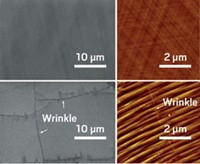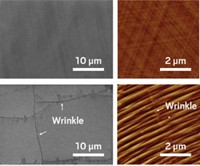Advertisement
Grab your lab coat. Let's get started
Welcome!
Welcome!
Create an account below to get 6 C&EN articles per month, receive newsletters and more - all free.
It seems this is your first time logging in online. Please enter the following information to continue.
As an ACS member you automatically get access to this site. All we need is few more details to create your reading experience.
Not you? Sign in with a different account.
Not you? Sign in with a different account.
ERROR 1
ERROR 1
ERROR 2
ERROR 2
ERROR 2
ERROR 2
ERROR 2
Password and Confirm password must match.
If you have an ACS member number, please enter it here so we can link this account to your membership. (optional)
ERROR 2
ACS values your privacy. By submitting your information, you are gaining access to C&EN and subscribing to our weekly newsletter. We use the information you provide to make your reading experience better, and we will never sell your data to third party members.
Materials
Crumpled Graphene Retains High Capacitance
Resistance to aggregation and sheet stacking bodes well for device scale-up
by Mitch Jacoby
February 18, 2013
| A version of this story appeared in
Volume 91, Issue 7
Graphene’s intrinsically high conductivity and extreme thinness should make it outstanding for use in advanced electronics such as ultracapacitors, a type of charge storage device. In practice, those properties are often difficult to exploit when standard procedures are used to prepare bulk quantities of graphene from graphite powders. Those methods tend to cause ultrathin graphene flakes to aggregate and form stacks, greatly reducing the material’s surface area and electronic and ionic conductivity. A recently developed aerosol-based method to make crumpled graphene sheets can overcome those problems, because like wadded paper balls, crumpled graphene sheets resist aggregation and compression. Jiayan Luo, Hee Dong Jang, and Jiaxing Huang of Northwestern University prepared a series of capacitors with increasing mass of crumpled graphene. The capacitance values increased roughly linearly with mass, suggesting that the devices could be scaled up to meet the needs of various applications (ACS Nano, DOI: 10.1021/nn3052378). In contrast, increasing the loading of flat graphene leads to successively weaker capacitance per weight of graphene, as the increase in material causes greater aggregation, the team reports.




Join the conversation
Contact the reporter
Submit a Letter to the Editor for publication
Engage with us on Twitter